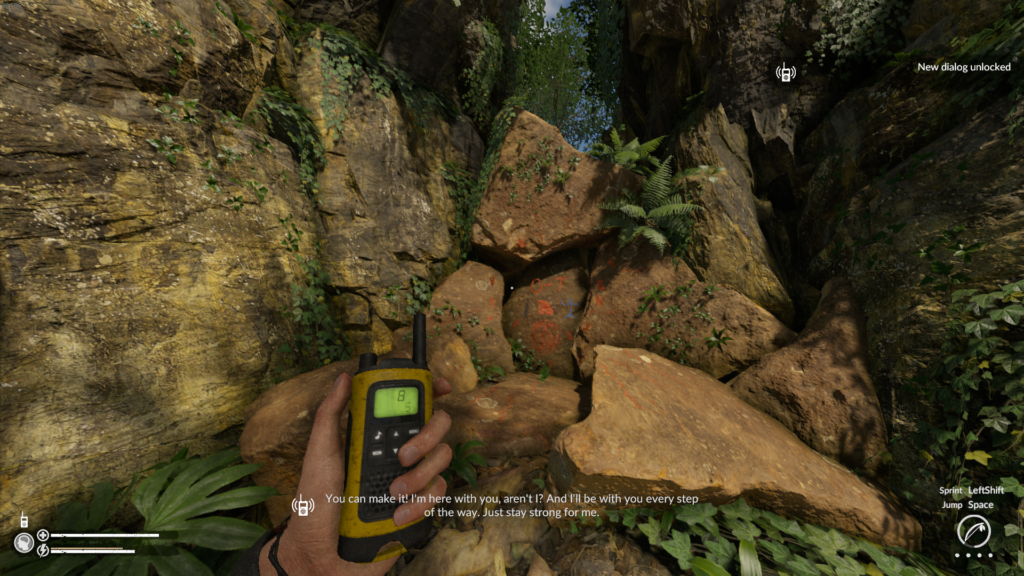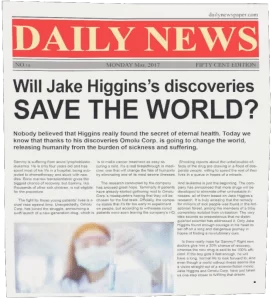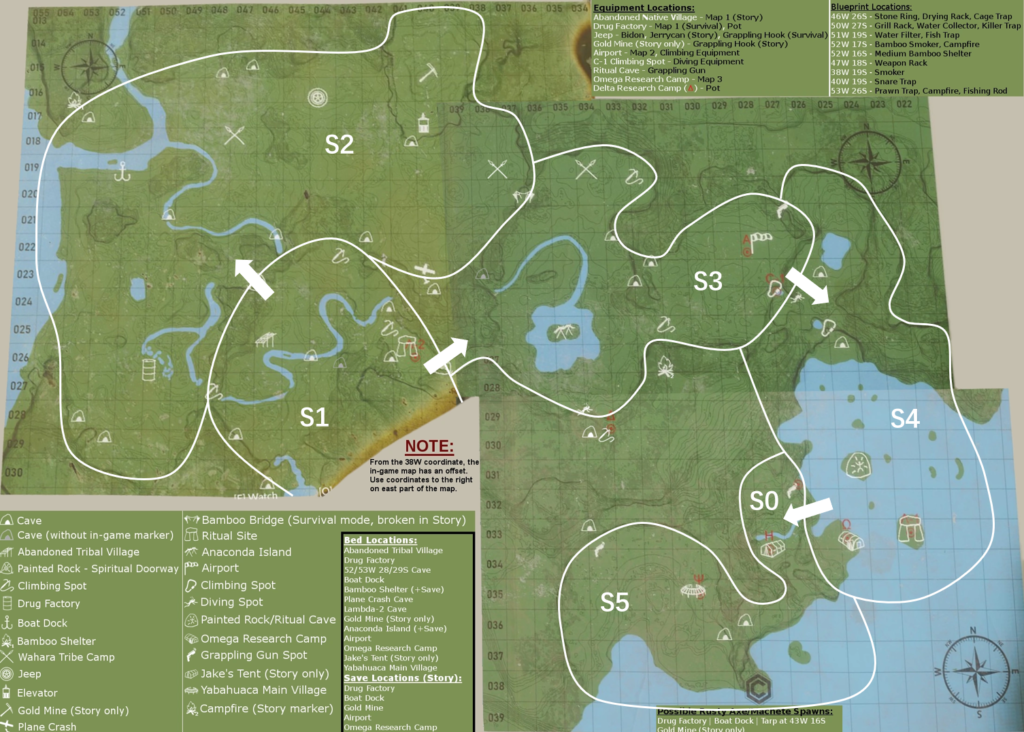1100 words | 3 minutes | Spoilers
Survival games got me obsessed again lately. A potential survival game designer role urged me to revisit this genre, so I went through a selection one by one: Green Hell, Rust, SCUM and No Man’s Sky. None of them made me feel like I was on a mission. In fact, these highly-rated survival games drew my attention as a player as much as a designer. Among these 4 games, I have spent the most amount of time playing and dissecting Green Hell, an open-world hardcore Survival game for both singleplayer and multiplayer.
Environmental storytelling in Metroidvania-like levels
Green Hell’s canon storyline is composed of scattered pieces of memories, revealed little by little to the player behind a thick curtain of Amnesia. In the game, the player plays as explorer Jake Higgins, with a goal to find his wife Mia in the jungle. During the exploration, Jake and Mia will have frequent conversations over a Walkie Talkie; but soon the player will find everything suspicious: Jake seems to have been through the same search long time ago, and Mia’s words doesn’t make sense at all sometimes. Only at the end of the game will the player realize that Jake has gone insane because his past discoveries led to the death of millions including Mia, and was actually talking to himself the whole time.
What’s unique about this narrative? It breaks down a main storyline and 3 short tales into pieces and smoothly weaved them into an open-world game play. The player will not be forced to do any specific task to recover these stories.
Aside from the storytelling, Green Hell’s Metroidvania-style map cut the map into several free-to-explore sections, with natural barriers in between that requires the discovery of a certain tool to pass through. This design prevents the player from getting spoiled before exploring the previous chapter thoroughly, further enhancing the feeling of “exploration”. Furthermore, with each tool added to the player’s backpack, the player will be able to unlock more optional points of interests and build camps in more remote locations. This mechanic gave the player a feeling of “leveling up” without an experience system nor a skill tree, keeping the difficulty and hostility of every map section around the same level.
After ~50 hours in Green Hell and a handful of notes, I finally felt confident to examine its worldbuilding and narrative thoroughly. Before examining its pros and cons, let’s go over a list and a database I put together first.


Green Hell’s playthrough, divided by sections

The player expects a two-people expedition, while learning the basics. The player now has almost no attatchment to Mia.
Jake and Mia’s camp
Cinematic (teleports the player into the next section)
– About missing the evacuation
The player spend most time learning to survive around a single camp, unaware of how big the world is. The player believes Mia is somewhere in the jungle.
Backpack (ritual note, map)
Ritual place (unlocks the stone gate)
Stone gate & cinematic (unlocks the next section)
– About the second visit to the jungle
The player realizes the others’ existence and starts to suspect Mia’s honesty. The player learns to track and move between multiple camps.
Discoveries of multiple modern structures can be found here.
Dock
Drug factory (Finding a Jeep track leading to the abandoned Jeep)
Jeep (Finding the fuel to enter the gold mine)
Gold mine (Finding the grapple to access the ritual place “Lambda 2”)
Wahara tribe
Plane crash
Ritual place “Lambda 2” (Unlocks the stone gate)
Stone gate, canyon & cinematic (Unlocks the next section)
– About how Mia had cancer
The player spends less time building upon repositioning multiple times.
Upon Mia’s disconnection, Jake’s sanity and Mia’s intentions will be doubted, raising the player’s curiosity and concern.
- Anaconda island
- Airstrip
- Metal hut (Acquiring climbing gear for the deep well)
- Deep well (Acquiring scuba diving gear for the underwater tunnel)
- Underwater tunnel (Leading to the next section)
The player needs minimal effort camping. The player learns that Jake had been here with a team, and feels guilty that Jake messed up their mission.
Finding the cure solely depends on if the player thinks about the foreshadowing of catchable frogs.
Omega camp
Ritual place “Lambda 1” (Unlocks the stone gate)
Stone gate & cinematic (Getting into the enclosed cave)
– Memories about curing cancer
– Memories about the spread of an unknown deadly virus
Enclosed cave (Acquiring the grappel gun needed for the next section)
The player doubts Mia’s fate upon seeing the destroyed village. Almost no time is spent camping here, as an ending can be felt approaching.
The player feels strongly attached to Mia and is very concerned about her potential death.
Jake’s camp (now abandoned, hinting a surprisingly long time has passed since tutorial)
Yabahuaca main village
Ritual place (Activates the cinematic)
Cinematic (Unlocks the ending)
– Mia gets the virus, heartbroken
– Yabahuaca massacred by the cartel because of the virus
– Jake’s expedition in Omega camp, going insane, getting amnesia
– Leaving before the expedition, seeing Mia in ventilation
Neutral and Bad ending, depending on if the player finds the cure for the virus or not.
Green Hell’s events, sequenced by chronologics or gameplay

The pros and cons of scattered environmental storytelling
Prior to Green Hell, I experienced strong environmental storytelling in The Witcher 3 (open-world) and the Bioshock series (linear). From my point of view as a player, it has the following benefits:
- Accessibility. The player doesn’t have to follow a pre-arranged sequence and is free to visit them at any point.
- Efficiency. Environmental storytelling can be mass-produced modularly in the form of documents and still scenes.
- Individuality. Each set stands on their own, while also capable of coming together to form a larger lore.
- Joy of discovery. Scavenging and looting are common elements in all types of games, and they can be greatly enhanced by environmental storytelling.
- Room of imagination. A well-designed site or document leaves the player wondering what happened to the people of interest, encouraging further explorations.
- Small audience group. Not every player has the patience to discover stories from fragments.
- Lack of interactivity and impact. A still object can be much less appealing and immersive than a storyteller, or a cutscene.
- Homogeneity. Documents, if not designed well, can fall into the same “letter/diary left by someone” cliche, making the discover uninteresting.